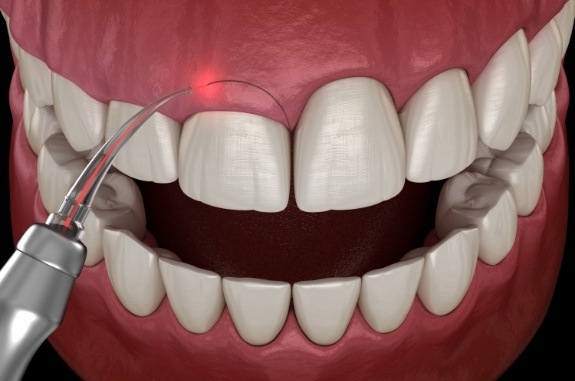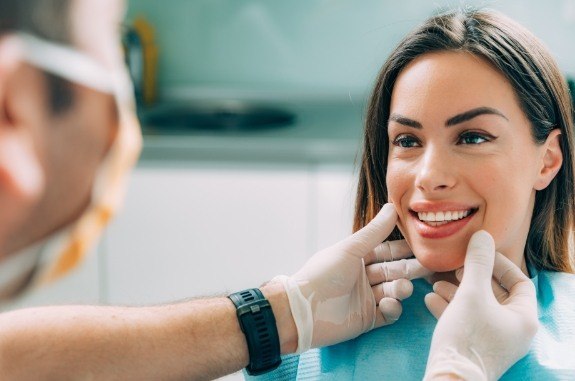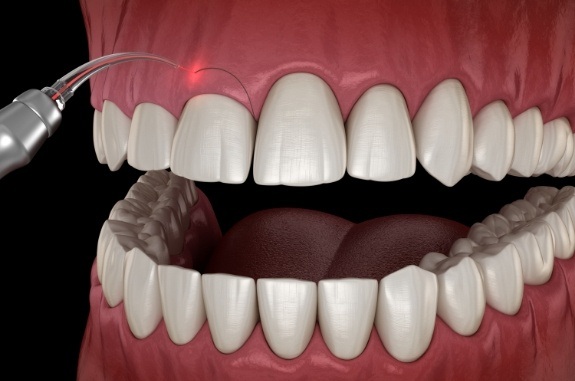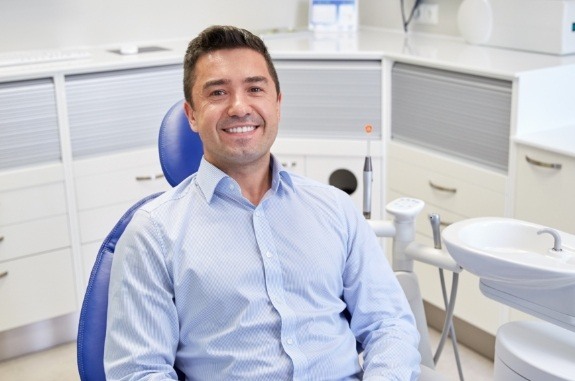Gingivectomy – Clute, TX
Removing Unwanted or Infected Gum Tissue
A gingivectomy is a procedure used for either cosmetic purposes or to treat the deep pockets formed by gum disease. This is a treatment in which the dentist removes gum tissues from your teeth and gums. This may be done if your soft oral tissues are infected by periodontitis or if you have too much gum tissue and want to remove them for aesthetic purposes. Please continue reading or contact us for a detailed discussion of a gingivectomy in Clute.
Why Choose Woodshore Family Dentistry for Gingivectomies?
- Specialty Dental Procedures Performed In-House
- Gentle, State-of-the-Art Dental Lasers
- Dental Team That Makes You Feel Welcomed
Reasons for Getting Gingivectomy Surgery

There are two primary reasons to get gingivectomy surgery — medical and cosmetic. The medical reason is related to your gum health if you suffer from injuries, gum disease, gum recession, or other such issues. The cosmetic reason relates to changing the gumline for aesthetic purposes. The following is a detailed overview of why you may need gingivectomy surgery.
Cosmetic Gingivectomy

A cosmetic gingivectomy is a procedure used to enhance the appearance of your smile. This is a completely safe procedure in which the dentist removes some of the surplus gum tissues from your mouth. This ensures that your smile looks less “gummy,” thereby enhancing your overall cosmetic appearance.
Periodontitis Gingivectomy

Periodontitis is an advanced gum disease in which plaque and tartar accumulate in your mouth and around your gumline. The accumulation of plaque and tartar also lead to bacterial infections, which spreads to the gumline, thereby infecting the gums and causing gum recession. If you don’t treat periodontitis, it will continue spreading and also infect your bones, for which you’ll need more invasive surgeries or even have your tooth extracted.
Furthermore, periodontitis also leads to complications like frequent bleeding due to gum sensitivity, bone loss, and even possible tooth loss. During the periodontitis gingivectomy procedure, the dentist will remove all of the infected gum tissues. This will treat gum disease and prevent the infection from spreading. Following that, the dentist will be able to thoroughly clean your teeth and gums to remove all bacteria.
Gingivectomy Procedure

A gingivectomy is a pretty simple procedure, and it can conclude within an hour, though that will depend on the amount of gum tissue that the dentist needs to remove, and the number of teeth from which the gums need to be extracted. If you need gum tissues removed from a few teeth, the dentist can complete the procedure in a single sitting, but if you need gum tissues removed from several teeth, you may need to return for multiple sessions.
The following is an overview of the steps involved in the gingivectomy procedure:
- A local anesthetic will be injected into your gums before the procedure begins. This is so you do not feel any pain while we are working with your gums.
- A small part of the gum tissue is removed with a scalpel or a soft tissue laser.
- We will suck out the saliva in your mouth. This is because it is easier for us to perform the gingivectomy in a dry environment.
- The unneeded or infected gum tissues are removed.
- The remaining gum tissue is carefully shaped by our dental laser, leaving an aesthetically pleasing smile behind.
- Since the treated part of the gum tissue will be sensitive for a while after the procedure, a soft protective gel and some bandages will be applied to protect it.
What Is Laser Gingivectomy? Can a Laser Help Treat My Gum Disease?

Laser gingivectomy is a procedure in which the dentist uses a laser to remove the gum tissues and shape the gumline. It is better than scalpel gingivectomy because it’s more accurate and it cauterizes the wound better so that your gums heal quickly. Laser gingivectomy also has a negligible risk of side effects like infections. It should, however, be performed by experts who are highly trained in the method.
After the infected gum tissues are removed, the dentist will still have to do a deep cleaning to ensure there is no more bacteria or tartar in your teeth and gums.
What Is the Difference Between Gingivectomy and Gingivoplasty?

A gingivectomy involves actual removal of the gum tissue, whereas gingivoplasty simply reshapes the gum tissue without taking any of it away. Gingivectomy is mostly performed for medical purposes, such as to stop gum disease from spreading. Meanwhile, gingivoplasty is typically used as a cosmetic procedure, although it can also be a preventive measure against cavities. The type of procedure that we recommend for your smile will be based on your needs.
Recovery from Gingivectomy

There are three stages in the recovery process from a gingivectomy:
- First Stage: Once the anesthesia wears off, you’re likely to experience considerable pain, for which you’ll need to use over-the-counter pain medication like ibuprofen. Your gums may even bleed often, and you’ll have to constantly replace the bandages to aid the healing process.
- Second Stage: You’ll experience some jaw pain occasionally for a few days. Your dentist will advise you to eat soft foods, rinse your mouth with saltwater, and use cold compresses to manage the swelling and pain.
- Third Stage: You’ll be perfectly alright within a week and may only experience slight soreness occasionally. You should visit your dentist in a week to make sure your gums are healing correctly. Following that, you can proceed with your regular eating habits and maintain your teeth with regular oral hygiene habits like brushing, flossing, and rinsing with a mouthwash. You should continue going for regular dental cleaning appointments to prevent periodontitis in the future.
How Much Does a Gingivectomy Cost?

The gingivectomy cost for a single tooth may be as high as $200 to $400. However, if you need a gingivectomy for several teeth, most dentists usually quote a discounted rate for the complete procedure. Since this is a medical procedure, it’s usually covered by insurance to a varying extent.
I Need a Checkup & Cleaning I Need a Dentist for My Child I am Worried About Gum Disease I Have a Cavity or Broken Tooth I am Missing One or More Teeth I Want to Enhance My Smile I Want a Straighter Smile I am Concerned About Sleep Apnea I am Scared of the Dentist I Have Pain in My Jaw I Have a Dental Emergency View Our Services


